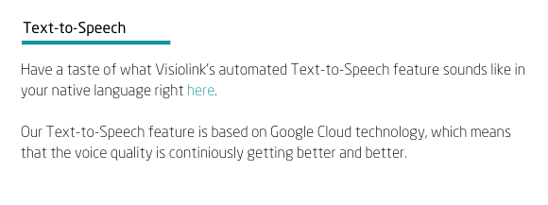Would you rather listen to the article? Press play and have the article read aloud by the Text-to-Speech Google Cloud speech synthesis.
Reader revenue and how to grow and retain your digital subscription base is key in the modern publishing industry. This marks a shift from the traditional advertising business model where KPI’s focus on traffic numbers and pageviews, to one in which engagement is at the very core. Growing your subscription base is one thing but retainment is key to building a sustainable subscription business. How do you retain your readers? You keep them engaged. What engages readers? Audio.
Audio content engages and retains readers
Engaged readers do not churn. That much is clear, and something the Danish news publisher, Zetland has experienced firsthand resulting directly from its introduction of audio content back in 2016. Entering in dialog with churning subscribers, Zetland discovered that one of the primary reasons for unsubscribing came down to not reading enough stories.
By introducing audio content, readers started actively using their subscriptions in a more stable manner. The average completion rate of Zetland’s narrated articles is 90%, whereas readers typically abandon a written article after only a few paragraphs – and because users listen via playlists, they consume more audio content.
Along the same lines, recent Visiolink data insights reveal that audio content increases engagement amongst epaper users. Diving deeper into our data on how epaper users consume audio content – human as well as automated text-to-speech narrated articles and podcasts – it was discovered that podcast users and users of narrated articles respectively use on average 7.9 and 3-5.5 times longer listening to the content than do those reading it.
Like Zetland, publishers such as The Economist, Harvard Business Review and The New Yorker, have also found audio content to be a great way of both retaining existing subscribers and attracting new ones.
Narrated articles present a golden opportunity for news publishers
Organisations such as WAN IFRA and Reuters Institute have long pointed to the prospects of audio content. In their most recent World Press Trends report, WAN IFRA clarifies that the popularity of podcasts is only expected to keep growing.
Add to this, the general ability of audio content to drive and retain subscribers and you have one very interesting business case for news publishers. Even though there is no denying the popularity of podcasts, Reuters Institute also points to the opportunities of other audio formats, such as synthetic narrated articles. An audio format, which has already found great support in e.g. Denmark, as early 2021 insights reveal how most news brands are already offering some kind of automated audio version of their news articles.
Furthermore, narrated news articles tap into certain user needs, which the podcast format has difficulty accommodating. Some of the main reasons why non-podcast-users shy away from the format are for instance lack of time and podcast episodes being too long.
Offering narrated – human as well as automated text-to-speech – versions of news articles not only provide an alternative to podcasts, it will also meet yet another very prevailing consumer need -– staying updated in the most convenient way possible.
While human narrated articles are of course the ideal, these require resources, which are not necessarily available to all news publishers. However, given that automated text-to-speech technologies come at a relatively cheap price point and continuously are getting better and better in quality, these present a great opportunity for news publishers of all sizes to tap into audio content and its many possibilities.
How to succeed with audio content
Even though there is no denying the possibilities, which audio content presents, succeeding with an audio strategy is not just a matter of plug and play.
Audio is on the rise, yes, and more and more consumers find that it conveniently fits into their busy daily lives and routines to listen to rather than to read the news. Visiolink data insights support this trend, as the average user increase in epaper podcast and human narrated article consumption was up 16.54% and 7.8% respectively per week in Q1, 2021. However, the quantity of news listeners still does not come near the quantity of news readers, and according to Reuters Institute, the speed at which consumers discover and adapt the use of audio content, e.g., podcasts, does not add up to the speed at which publishers are supplying it.
For instance, in Europe, an average of 17% still does not know what a podcast is. This is twice as many as in the U.S. Adding to this, audio content is particularly popular amongst younger consumers, which suggests that succeeding with an audio content strategy requires raising awareness amongst subscribers as well as helping along a change of habit – something which just does not happen overnight.
Reuters Institute further argues that there is room for news publishers to promote audio content even more. So does those, who have already come far with their audio content strategy, such as Visiolink customers, Dag og Tid and NOZ.
Want to know more about the measurements taken by NOZ and Dag og Tid to help their readers discover their respective audio offerings? Then you can learn more about NOZ’s approach towards audio content here and Dag og Tid’s approach here.





